Pictures of North Korea, part 3: first views of Pyongyang
Continuing writing about my North Korea trip… More pictures. Click on them for larger views.
- Our first morning driving out from the hotel. We experienced driving in North Korea for the first time the night before, coming in from the airport. We landed in the early evening, but night had fallen by the time we reached the city. With almost no streetlights the city was dark. People kept narrowly getting out of the way of the bus. We kept getting shocked that a family wouldn’t hurry and would barely not get hit. We soon concluded North Koreans don’t have much experience with cars. The streets were nearly always empty.
- We nearly never stopped for traffic lights. We never hit traffic. The cars we saw were a mix of decades-old Soviet-looking clunkers and modern, sometimes luxury cars, I guess reflecting the class divisions of the society. I took this picture to show the industrial, Soviet appearance of the engineering, as well as the slow pace of life and low population density. One day toward the end of the trip on a rainy day we saw a soldier starting a truck with a hand crank. When was the last time anyone manufactured a vehicle that started by hand crank? Not many people support the North Korean military, but as a human being he seemed reduced to having to do something undignified in the rain.
- More Soviet industrial appearance. The North Korean government derives from communism, which would suggest a classless society. But the government stratifies the culture into three main groups according to loyalty to the party or leaders. As I understand the most loyal live in Pyongyang and enjoy the most material prosperity, making up something like ten percent of the population. The lowest group constitutes those who are suspect or oppose the party — maybe their ancestors collaborated with the Japanese — and probably constitute about half the population. They further subdivide the groups into fifty-one strata with very little chance for upward mobility. I think downward mobility can happen easily and devastatingly, meaning prison camps.
- One of the nicest buildings we saw. From this picture it could have been Miami Beach. On the first day I didn’t remark about the building, but now I’m surprised at the amount of unnecessary style in it. Most other buildings were purely functional, except government buildings. I wonder what led to the decision to make it round, give it decks, and stagger the decks spirally. Those design features must have cost money, but who has incentive to add them and who can pay for them? Do party leaders live there? (EDIT: see comment from a reader below, who found out about these buildings, including a video of them).
- Going to North Korea in 2011 means pictures you take of anything have potential interest to someone, since almost no one visits. I can’t think of why I took this picture. Still, it shows daily life in Pyongyang — empty streets, low population density, no one hurrying. I think the river was on the other side of this little hill.
- Like the round building above, this building looks like it could be in Miami Beach — a bit of color, green palm-like trees at the base, patios. You can’t see the detail from this picture, but the building wasn’t in great shape. The surface was peeling. Something about the construction didn’t look solid. At the time I thought maybe preconceived notions biased me. As we came to see almost no buildings not for government seemed well-constructed, I concluded they probably built very few buildings to high standards. Then again, many buildings in Beijing and outside Shanghai’s center didn’t look any more solid.
- Now that I think of it, I think they may have asked us not to take pictures from the bus, but I don’t remember. In a short time we got comfortable with our guides — we didn’t push limits and they relaxed with us.
- One of my early surprises was the lack of billboards. In fact, I plan to explore in this blog how the lack of advertising unexpectedly made me think and reflect on my society — how we could see more countryside without all the signs, for example. Of course they have their share of signs influencing the thoughts and behavior of their population — through government propaganda instead of corporate marketing. I believe I tried to capture a propaganda sign on the right in this picture, but it looks like no more than a picture of a flower. I missed photographing all the biggest and most dramatic signs we passed.
- All cities have rivers. Pyongyang’s lazily meanders through, flat and wide. Like the river, no one hurries. I’m in New York City now, where many people hurry. I don’t consider hurrying virtuous, but I feel it implies motivation and drive.
- I don’t know what defines communism. I’ve read some Marx and Engels in college. I remember it describing problems with capitalism and how capitalism would lead to its own collapse through creating a working class large enough to overthrow the capitalists. But I don’t remember it prescribing the ensuing government’s form or structure. A country calling itself communist doesn’t seem to constitute it being communist. After all, North Korea calls itself a republic, which it isn’t. In any case, one of my earliest memories of people discussing economic systems was a high school friend, now living in Japan, saying a major problem with communism was that removing the opportunity for personal profit removed motivation to produce or even to act. You saw that everywhere in North Korea. They motivate their people in other ways, but we didn’t observe that in our trip.
- The public transportation infrastructure seemed old and decrepit. I presume it functioned okay. I figure much of it came from cold war Eastern Europe, which would explain its age and lack of spare parts. One of the saddest sights I remember was a bus with a badly cracked plexiglass front window. The bus was old and likely not made in North Korea. They “repaired” the crack by bolting on some other piece of plastic to hold it all together. More than looking terrible, it signaled boldly to everyone that “we, the public transportation people, can’t fix the most public problems with our system needing only cheap parts.” Yes, a bus works with a cracked front window, but it implies a system more out of control than, say, the most graffiti-covered train in New York’s nearly bankrupt days. I mean, who doesn’t support public transportation? It felt shameful.
- People going about their business, with silhouettes from us in the bus in the foreground. One of my more common ways to describe visiting North Korea is that it is visiting Nineteen Eighty-four and Animal Farm. Even Airstrip One had color here and there. Pyongyang had a fair amount of green. I don’t know what this rose communicated. I photographed it to catch some propaganda but missed the shot again.
- This picture doesn’t capture the mass of this housing complex. It appeared mammoth and monotonous. I guess most cities have such massive public housing of some sort. New York City has its share of housing projects. This one’s shape and size reminded me of the Watergate in Washington DC., but this one looked purely functional, with no frills.
Read my weekly newsletter

On initiative, leadership, the environment, and burpees
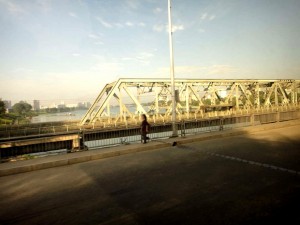

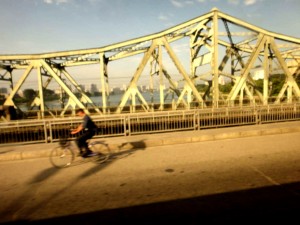
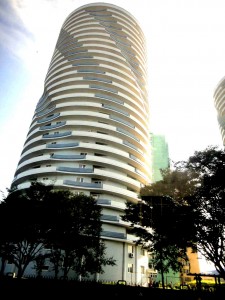
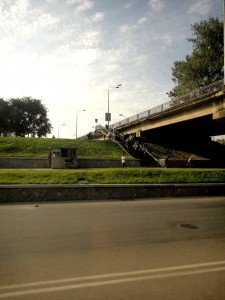
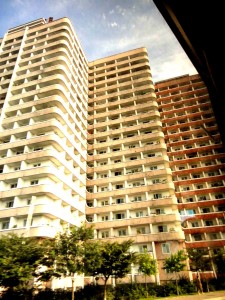
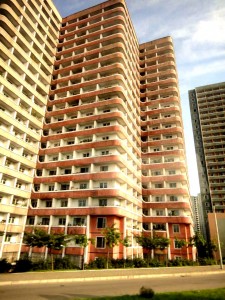
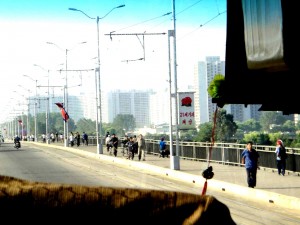
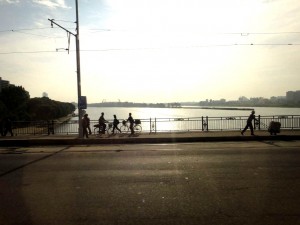
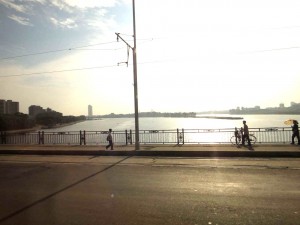
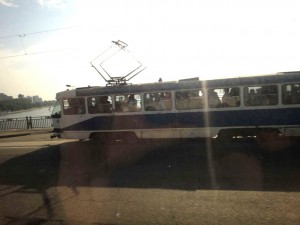
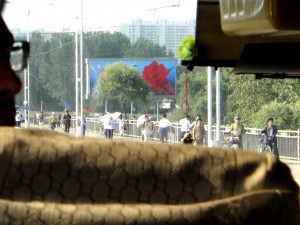
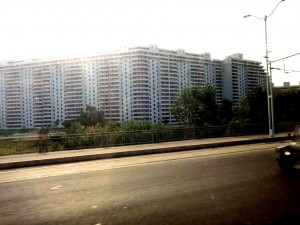
2 responses on “Pictures of North Korea, part 3: first views of Pyongyang”